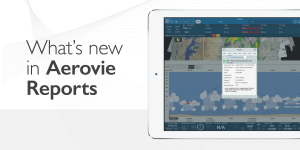
Aerovie Reports began as a fairly niche app, mostly known as a way to submit and review PIREPs. In the past 6 months, though, the app has grown into much more and can now be considered a full electronic flight bag (EFB) app. Its strong point is weather, both preflight and in-flight; here are four unique features to know about.
1. Simulated reflectivity. One of Aerovie Reports’ best features is its wide variety of weather products, and radar is no exception. In addition to the basics, the app offers base reflectivity, composite reflectivity (showing the strongest echo throughout all tilt angles), 24-hour precipitation and “HRRR Simulated Composite” and “NAM Simulated Composite.” These last two images are often called “forecast radar,” and that’s essentially what they are: numerical model outputs that try to predict the precipitation for the next one to three days. It’s not exact, but it’s a helpful planning tool, and it’s easy to use in Aerovie Reports.

2. Icing graphics overlay. The CIP and FIP products are some of the most useful forecasts in aviation, especially for piston pilots who are constantly worried about in-flight icing. They show the forecast probability and severity of in-flight icing, at different altitudes and at different times in the future. It has been refined to the point where it’s an extremely accurate forecast (in our experience). While the static charts are fine, Aerovie Reports allows pilots to overlay these charts right on the main moving map page. This is ideal for planning your route, and it’s easy to move forward and backwards through the forecast period, as well as choosing different altitudes.

3. Skew-T and meteograms. METARs and TAFs are essential weather products for any pilot, offering current and forecast conditions at a particular station. But sometimes it’s helpful to dive a little deeper, and that’s where a Skew-t Log-p diagram and a meteogram come in handy. These are definitely geeky weather products, but with a little training they reveal information you really can’t find anywhere else. In Aerovie Reports, simply tap on an airport, then choose from SKEWT, METEOGRAM or GFS MOS.

4. Vertical weather forecast. Weather is obviously a three dimensional issue for pilots, and here’s where Aerovie Reports’ latest feature really comes in handy. First, plan a route using the FPL button at the top of the page. If adverse conditions are forecast, you’ll see color-coded alerts at the bottom of the flight plan page. Tap on these (e.g., ICE in red) and you’ll see a pop-up warning.

Tapping on “Open Vertical Weather Profile” will display a new window at the bottom of the app. Here, you can see estimated cloud levels, freezing level, precipitation and PIREPs. Tap on a PIREP for complete details, or on an airport for current/forecast conditions. There’s a lot of information here, but it’s well presented. As always, remember that a lot of this data is based on forecasts, not actual conditions. That means it should be treated with a skeptical eye, but it’s far better than guessing.

Aerovie Reports does offer more than just weather, with detailed airport information, instrument approach plates, ATC suggested routes and flight plan filing. It’s not quite as full-featured as ForeFlight or Garmin Pilot, but it’s making rapid progress. There’s also a great app for Apple Watch – although it tries to do a little too much sometimes, it is packed with information.
Aerovie Reports is free to download on the App Store. An annual subscription costs $69/year.
Source: Ipad appsAerovie app grows up – 4 features to know about